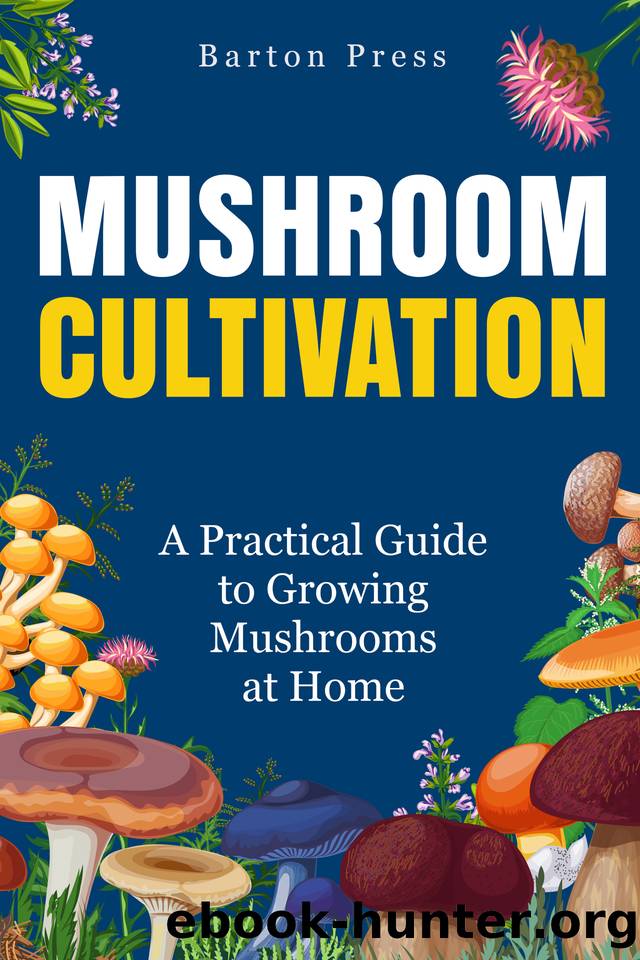Mushroom Cultivation: A Practical Guide to Growing Mushrooms at Home by Barton Press

Author:Barton Press [Press, Barton]
Language: eng
Format: azw3, epub
Published: 2021-02-15T16:00:00+00:00
Once the mycelium has weakened and its food and moisture have run low, it will be vulnerable to contamination. So after the first couple of flushes, keep an eye out for any discoloration or other signs of mold growth. If you see mold, discard the cake and sterilize the monotub immediately to prevent contaminating the grow space.
Mushroom Grow Bag
Mushroom grow bags are a cheap and easy method for growing a wide variety of species. Not only can they be used as a self-contained fruiting environment, but theyâre also great for making a large quantity of spawn for use in other growing techniques.
A mushroom grow bag is a polypropylene bag that has a filter patch attached to it to assist with fresh air exchange while keeping contaminants out. The bags are gusseted, allowing them to expand and hold a good amount of substrate or spawn.
Theyâre autoclavable as well, meaning they can withstand the high temperatures necessary for sterilization in a pressure cooker. This means the bag wonât melt unless it is kept at a temperature of 266° to 340° Fahrenheit for an extended period of time. This makes them the ideal candidates for sterilizing a large quantity of grain or wood substrate at the standard 15 PSI.
These bags can be found for rather cheap online, or you can build one yourself (although since they are inexpensive, buying is preferrable). The bags have several uses for the home mushroom cultivator. You can use a mushroom grow bag as a spawn bag, to make fruiting blocks, to pasteurize a large amount of bulk substrate, or as a self-contained fruiting chamber.
When using the bag as a fruiting chamber, the top of the bag creates a humidity dome, while the mushrooms will spawn from the colonized block of substrate thatâs at the base. The main issue with this is lack of fresh air exposure, so when fruiting in a bag, itâll need to be opened and fanned regularly.
The main drawback to using a mushroom grow bag is the lack of reusability. While it is possible to reuse them for other purposes (as long as you donât have to cut the bag), youâll eventually need to discard it. When using mason jars and a fruiting chamber like a monotube, everything can be used repeatedly. Buying new bags for each grow isnât too costly though, but itâs definitely not environmentally friendly.
While there are several different ways to use a mushroom grow bag, below weâll cover how to create a fruiting block that can grow a large quantity of fruits:
Necessary Materials:
â Mushroom grow bag with 0.2 to 0.5 micron filter patch
â Substrate (to make a ~5-pound block) will include:
â 5 cups of hardwood pellets
â 1.4 liters of water
â 1.25 cups of wheat bran
â Mushroom spawn, liquid culture, or a colonized agar plate
â Gloves
â Zip ties
â Tyvek material (either Tyvek envelopes from the post office or a piece of a Tyvek painterâs suit)
â 70% isopropyl alcohol
â Bleach solution (10% bleach, 90% water)
â Perlite
Necessary Tools:
â Pressure cooker
â Glove box
â Large
Download
Mushroom Cultivation: A Practical Guide to Growing Mushrooms at Home by Barton Press.epub
This site does not store any files on its server. We only index and link to content provided by other sites. Please contact the content providers to delete copyright contents if any and email us, we'll remove relevant links or contents immediately.
Sapiens: A Brief History of Humankind by Yuval Noah Harari(13993)
The Tidewater Tales by John Barth(12397)
Mastermind: How to Think Like Sherlock Holmes by Maria Konnikova(6940)
Do No Harm Stories of Life, Death and Brain Surgery by Henry Marsh(6689)
The Thirst by Nesbo Jo(6442)
Why We Sleep: Unlocking the Power of Sleep and Dreams by Matthew Walker(6362)
Life 3.0: Being Human in the Age of Artificial Intelligence by Tegmark Max(5193)
Sapiens by Yuval Noah Harari(5125)
The Longevity Diet by Valter Longo(4861)
The Body: A Guide for Occupants by Bill Bryson(4587)
The Rules Do Not Apply by Ariel Levy(4525)
The Immortal Life of Henrietta Lacks by Rebecca Skloot(4261)
Why We Sleep by Matthew Walker(4192)
Animal Frequency by Melissa Alvarez(4156)
Yoga Anatomy by Kaminoff Leslie(4107)
The Hacking of the American Mind by Robert H. Lustig(4090)
All Creatures Great and Small by James Herriot(3988)
Barron's AP Biology by Goldberg M.S. Deborah T(3946)
Double Down (Diary of a Wimpy Kid Book 11) by Jeff Kinney(3930)
